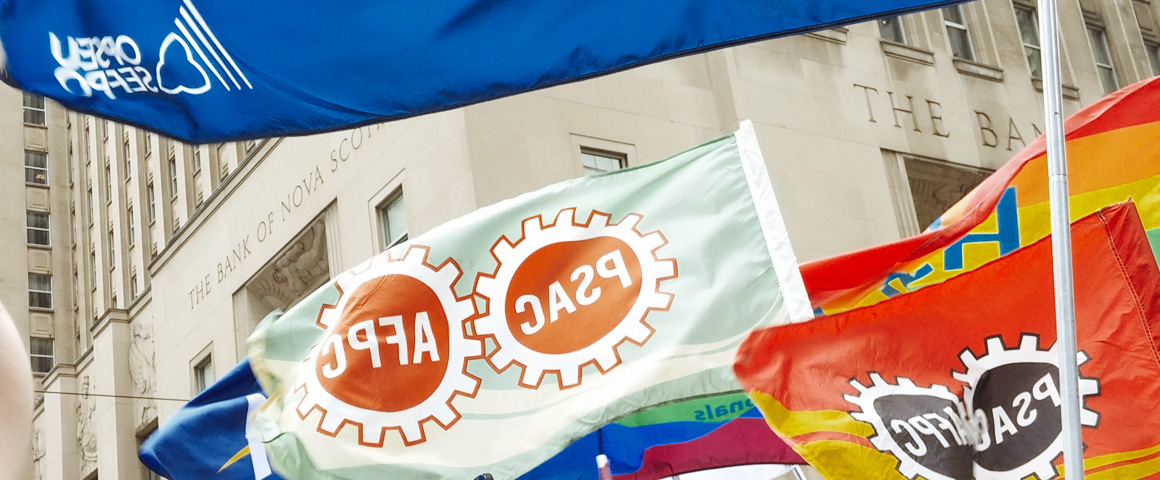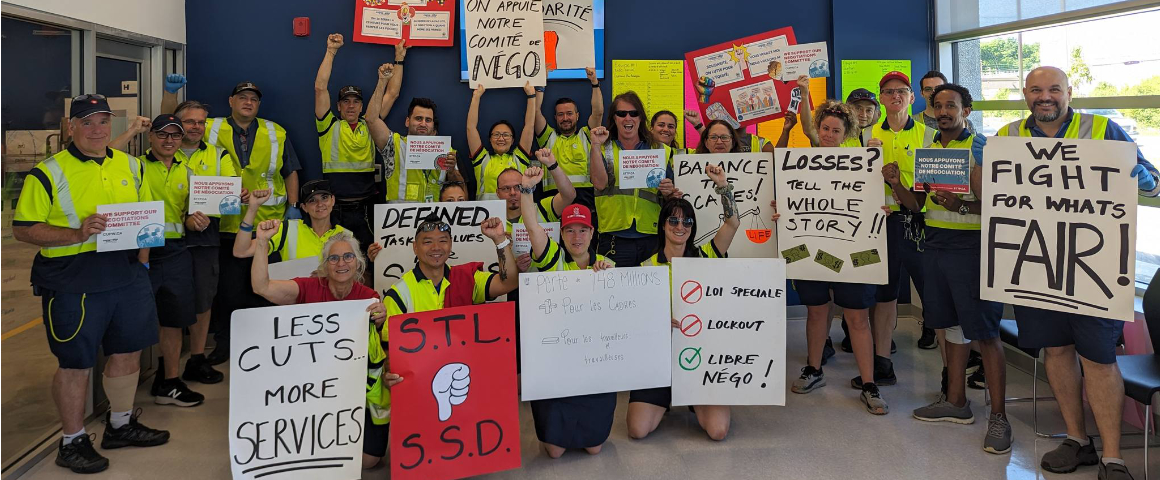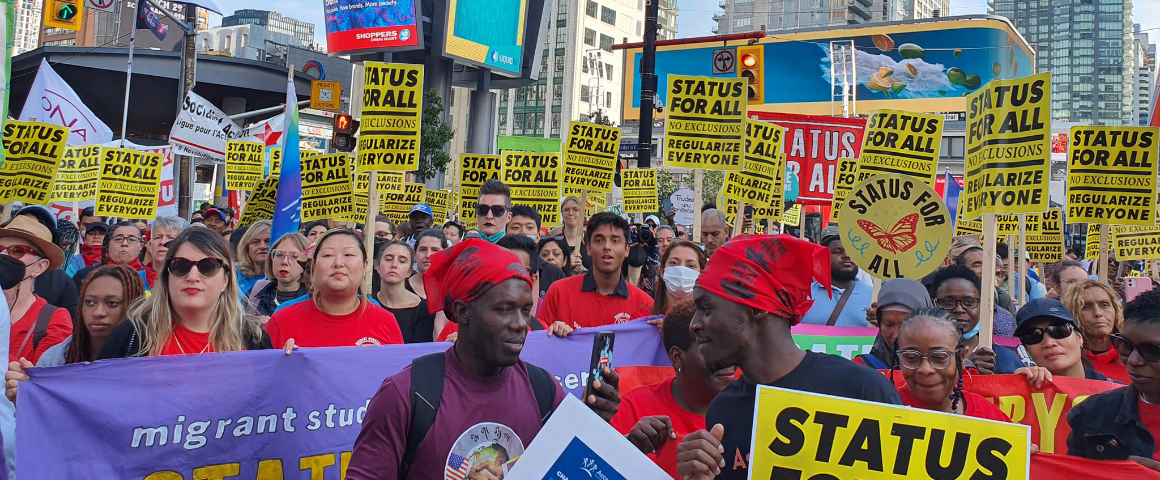While three of the four table officers coming into the May 8-12 convention of the Canadian Labour Congress were re-elected, and a progressive activist from the Public Service Alliance received the most votes of any candidate, the question remains whether the Canadian labour movement will be in a position to respond to the challenges facing the working class in the age of Trump.
Off the convention floor there were many signs of potential for militancy for progressive change. U.S. Black liberation activist and former Vice-Presidential candidate Angela Davis ignited hundreds of delegates and social activists on the eve of the Convention at the Human Rights forum by calling for a labour movement that is less hierarchical and inclusive, and accepting the struggles of women and black activists and the fight for $15 as the core of the success. She emphasized that movements can defeat the powerful, and that Marxism was still relevant to the struggle because we are still facing capitalism.
The Canadian Union of Postal Workers organized a panel calling for a Solidarity coalition, with representatives from the Halifax Labour Council, the London Labour Council, the Secretary-Treasurer of the BC Government Employees Union and the outgoing Chairperson of the Canadian Federation of Students citing successes in organizing in their communities.
A panel at the end of the convention looked at unconventional methods of community organizing such as the Workers’ Acton Centre, the Chicago Teachers Strike, and the efforts of the Toronto Labour Council to organize within ethnic enclaves.
There were some positive developments arising from Convention decisions that can provide opportunities for militant action within the labour movement. There will be four labour council representatives on the Canadian Council from the different regions of the country – Ontario, Prairies, British Columbia and the Atlantic.
An emergency resolution started by rank-and-file delegates supporting the Palestinian Prisoners’ Dignity Strike for their civil and political strike made the floor and was supported overwhelmingly by the delegates.
But political and structural issues within the Convention structure and the labour movement remain obstacles in developing a united militant democratic movement to challenge the threat of the neo-fascist business agenda of the Trump Administration and the neo-liberal policies of the Trudeau Liberal government and provinces across the country.
The major union divide behind the scenes at the convention was the rancor over the dispute between Unifor and the Amalgamated Transit Union, concerning the attempt by former ATU Local 113 President Bob Kinnear to appeal to the Canadian Labour Congress to have the local representing Toronto Transit Commission workers to became a direct affiliate to the CLC while it sought a new home. Once it became known that Kinnear had approached Unifor for legal advice, Unifor National President Jerry Dias went public in supporting the right of the local to become part of a Canadian union.
ATU put the local under trusteeship and started charges of raiding against Unifor. An interim report by Barry Thorsteinson, CLC investigator/mediator, criticized both the International ATU for putting the local under trusteeship, and Unifor for being in breach of the rules against raiding. But when Kinnear withdrew the application because he did not have support from the local membership, no further action by the CLC was needed.
Unifor sought to have the constitution of the International ATU declared in violation of the Constitution of the CLC. While apparently fireworks occurred at the Canadian Council meetings held during the convention, the issue was decided at that level and never hit the floor. The only reference was a statement by ATU Canada Director Paul Thorp thanking the Canadian Council for its resolution of the dispute on Wednesday morning. He emphasized that the ATU’s constitution was no one’s business but those of its members, and that ATU remained loyal to the CLC.
Lawsuits were dropped and a committee was established to review Article 4 of the CLC Constitution which deals with disputes. One concern may be that it will be made more difficult for a local of an international union, or a Canadian section of an international union which genuinely wants to become part of a Canadian union, to be able to do so.
The issue also played a major role in the votes for Secretary-Treasurer and Executive Vice-Presidents. Marie Clark-Walker was challenged for the Secretary-Treasurer position by Ferne Downey from ACTRA, who had announced her candidacy at the United Steelworker convention in Las Vegas. Downey was backed by part of CUPE, despite the fact that Clark-Walker was a CUPE activist before being elected CLC Vice-President on 2002. Clark-Walker was elected by 1900 to 1200 votes.
NUPGE nominated Sharon Skidmore from the BC Government Employees Union for Executive Vice-President, so that it would retain a representative on the top four positions, given that former Saskatchewan Government Employees Union member Barb Byers was retiring. That meant that Donald Lafleur from the Canadian Union of Postal Workers was potentially going to be knocked off the position to which he had been elected in 2014, by Larry Rousseau from the Public Service Alliance.
As it turned out, the faction led by Unifor brought in more buses of delegates than the Steelworkers on the day of the election. Rousseau had 2900 votes, while Lafleur got 1700 votes to Sikdmore’s 1400. Once the vote results were announced, the bussed-in Steelworker delegates poured off the convention floor, and no doubt the Unifor delegates did the same.
The convention agenda left little chance for rank-and-file delegates to participate. Policy papers on a green economy, organizing, good jobs, and equity had good preambles, but the action items were watered down. 250 resolutions were amalgamated into 17 composite resolutions. Controversial resolutions, such as one to support the boycott, divestment and sanction campaign against Israel, or one calling for action up to and including a general strike against Bill C-27 (bringing targeted pension plans to replace defined benefit pensions) were referred to the Canada Council rather than being debated on the floor.
The agenda was full of videos and guest speakers, and panels of experts on different issues, leaving usually only 1-2 hours per days to debate the resolutions. Delegates known as “mic muffins” were designated to hold place for the leaders of affiliates to speak on the issues of the day. On Thursday, a frustrated union member demanded that a resolution opposing Islamophobia be brought to the floor for debate, but was told that the convention had to attend to the order of the day, a tribute to outgoing Secretary-Treasurer Barb Byers. Once that was completed the Convention adjourned and no further deliberative business occurred.
Where does that leave the labour movement as its faces the upcoming challenges? While the more progressive candidates were elected, what chances do they have to bring rival unions together on a fightback campaign?
Donald Trump has just given 90 days-notice to the U.S. Congress that he intends to renegotiate the North American Free Trade Agreement. The agenda of the Trump administration will be to attack labour rights by facilitating right-to-work legislation, and cut wages for up to 50%.
The labour movement under Bob White fought against the passage of NAFTA in 1993, because it saw the treaty as a continental corporate constitution to undermine Canadian sovereignty. Trump’s negotiators will attack labour rights and Medicare, and will challenge what little environmental protections the Trudeau Liberal government might want to implement.
What is needed is a labour movement of the type that Angela Davis called for on the eve of the Convention. A resurgent Action Caucus can work with the activists envisaged by CUPW’s solidarity coalition. Activists can push the leaders of the affiliates who control the CLC Canadian Council to adopt a political agenda which puts the workers and the people ahead of the corporations who benefit from the free trade agreements like NAFTA or the Trans Pacific Partnership, which the Trudeau government wants to resurrect.
Such an agenda can include: a massive social housing program to deal with the housing crisis in Canada; a higher minimum wage across the country; investment in value-added manufacturing rather than shipping our natural resources to other countries to use for their economies; expanded social services to include a national pharmacare program.
Rather than lawsuits over jurisdictions of existing unions, the labour movement should be concentrating on organizing the numerous workers stuck in precarious employment. It should ally with social movements such as ACORN, Fight for $15 and Fairness, Black Lives Matter and Idle No More.
The task for progressive trade unionists is enormous but necessary. The time to organize is now.




